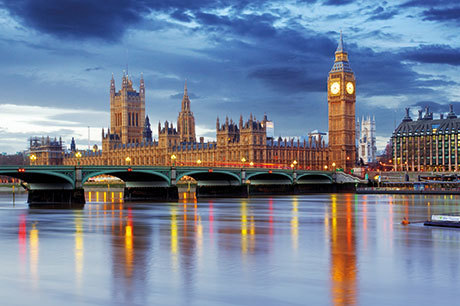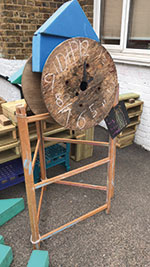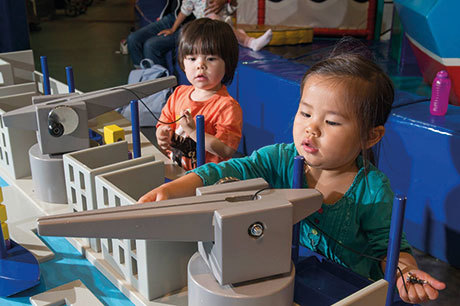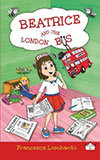
Download the PDF of We've explored...London
The lure of London motivated children from Porters Grange Primary School in Southend-on-Sea to build their own model of the capital, complete with famous landmarks.
Teachers Kate Clifton, Emma Jackson and Francesca Ross moved up from Reception to Year 1 with the children and have worked hard to smooth the transition and ensure that the children remain happy and independent in their learning within an enabling environment.
‘We know the children’s capabilities and are really enjoying making sure that this year is less restrictive and closed. The children’s day includes phonics and maths input but also has continuous provision in both the morning and afternoon,’ explains Mrs Clifton.
‘We’ve learnt that we can’t ever plan an activity as well as the children can lead it so we let the children have ownership and then pose questions and suggestions, model and encourage them, which is much more powerful.’
MEANING AND PURPOSE
 Children’s investigations of London actually started with Bonfire Night and the story of the Gunpowder Plot, but it was the geography of the city that appealed to the children, despite many of them being initially unfamiliar with it.
Children’s investigations of London actually started with Bonfire Night and the story of the Gunpowder Plot, but it was the geography of the city that appealed to the children, despite many of them being initially unfamiliar with it.
‘We talked to the children generally about London and a few of them had visited and been on trains, buses and the Thames Clipper. But the school is in quite a deprived area and the children’s experiences are not necessarily rich,’ says Mrs Clifton. ‘We find that we really have to use play to bring things alive. We find it’s the best way to teach the children because then it has meaning and purpose rather than engaging them in something that is abstract.’
The children were provided with maps of London so they could locate the Houses of Parliament. A visit to the school library to find related books led to some children becoming immersed in A Walk in London by Salvatore Rubbino, an illustrated look at the city (see Book corner).
‘Children either switch on or switch off, and this time we found that the geography side and looking at landmarks switched them on to learning more than the history objective,’ Mrs Clifton recalls.
Children discussed the various London landmarks and their own experiences, but the focus really came to life when the class received a delivery of new building blocks and a group of boys independently began to build a replica of Big Ben.
‘We encourage the children to be independent and resource their play. The children were going off to the design and technology area and grabbing tape and rope, string and scissors. They got old crates, hoops, rope, boats from the water play and people from the small world play area,’ says Mrs Clifton.
BUILDING BRIDGES
 She supported the children by encouraging them to think what other landmarks are close to the Houses of Parliament and photocopied pages of A Walk in London for the children to lay out in the block play area and refer to. They discussed the direction of travel and realised that they could create a 3D landmark ‘map’ all the way to Tower Bridge.
She supported the children by encouraging them to think what other landmarks are close to the Houses of Parliament and photocopied pages of A Walk in London for the children to lay out in the block play area and refer to. They discussed the direction of travel and realised that they could create a 3D landmark ‘map’ all the way to Tower Bridge.
Children then began to pull over gym mats to form the River Thames and started to build Tower Bridge across it using crates to make the distinctive shape of the bridge. Some of the boys are interested in engineering, how things work and mechanisms and they carefully used planks of wood to slide in and out from the crates to mimic the bascule design.
‘We very much build on the children’s creativity and allow time for them to think for themselves and to discuss. For example, the children knew that the London Eye was round and found a hoop from the physical development area, but they struggled to attach the “wheel”,’ explains Mrs Clifton. ‘I suggested that they use string to attach it and showed them how to weave it through the hoop and over the crate. The children soon got the rhythm of weaving so that they could attach the hoop.’
Some children decided to draw pictures and labels for the map and sought resources such as small-world people to – rather precariously – ride on the London Eye, and boats to sail on the Thames.
After the interactive map was completed, many of the children used it as a giant small-world play area with people and cars crossing the bridge. ‘It was very much a language-rich environment. Children were taking turns, negotiating and role playing such as being taxi drivers and taking passengers from Tower Bridge to Big Ben,’ reflects Mrs Clifton. ‘It was a purposeful activity rather than something that was simply created and then demolished. It stayed up in the setting for a couple of days. We’re so proud of what the children created.’
A TRIP TO THE MUSEUM
Many museums around the country are now geared up for younger visitors, so make the most of what your local museums have to offer and the insights that they can give pre-school children into a local city’s past and its development.
Nursery-aged children will relish a visit to Mudlarks, a free interactive learning space for younger visitors at the Museum of London Docklands.

The gallery introduces the stories told within the museum in a fun and stimulating way. Children can try loading cargo in Tip the Clipper, explore the Victorian docks in Docklands Playtime or become a builder in the museum’s building role-play area using giant bricks and wheelbarrows.
For more information, visit www.museumoflondon.org.uk
BOOK CORNER
Fiction
 A Walk in London by Salvatore Rubbino
A Walk in London by Salvatore Rubbino
The diversity and delights of London are captured in this detailed picture book which follows a girl’s walk around the city and its famous landmarks. The story is accompanied by interesting facts.
Katie in London by James Mayhew
 A Trafalgar Square lion magically comes to life and takes Katie, her brother and Grandma on a wonderful tour of the city’s sights.
A Trafalgar Square lion magically comes to life and takes Katie, her brother and Grandma on a wonderful tour of the city’s sights.
The Queen’s Hat by Steve Antony
A sudden gust of wind blows off the Queen’s hat and sends her and the Queen’s men on an adventure of the city. Where will the hat land?
Charlie and Lola: We Completely Must Go to London by Lauren Child
‘London is extremely huge and very BUSY… I can’t wait!’ says Lola as she sets off with her brother on a school trip to the capital city.
Beatrice and the London Bus by Francesca Lombardo
Beatrice dreams of being the driver of a Routemaster bus through London and taking in the city’s impressive landmarks.
 London Calls by Gabby Dawnay
London Calls by Gabby Dawnay
A rhyming adventure taking in the sights and sounds of the capital city as the reader zooms past parks and palaces, museums and monuments.
Non-fiction
 London for Children by Matteo Pericoli
London for Children by Matteo Pericoli
Explore the north and south banks of the River Thames with this beautifully illustrated book. The vibrant pictures are accompanied by historical and modern-day facts.
 Big Picture Book of London by Rob Lloyd Jones
Big Picture Book of London by Rob Lloyd Jones
Pages on London’s parks, transport and sporting events and two fold-out pages showing all the bridges and landmarks along the Thames.
Pop-up London by Andy Mansfield
This book from Lonely Planet Kids contains six pop-ups and illustrations to introduce children to the city, from the modern Shard to the Tower of London.
 London Children’s Map by Kourtney Harper
London Children’s Map by Kourtney Harper
A colourful simplified map of central London featuring all the main museums and attractions.









